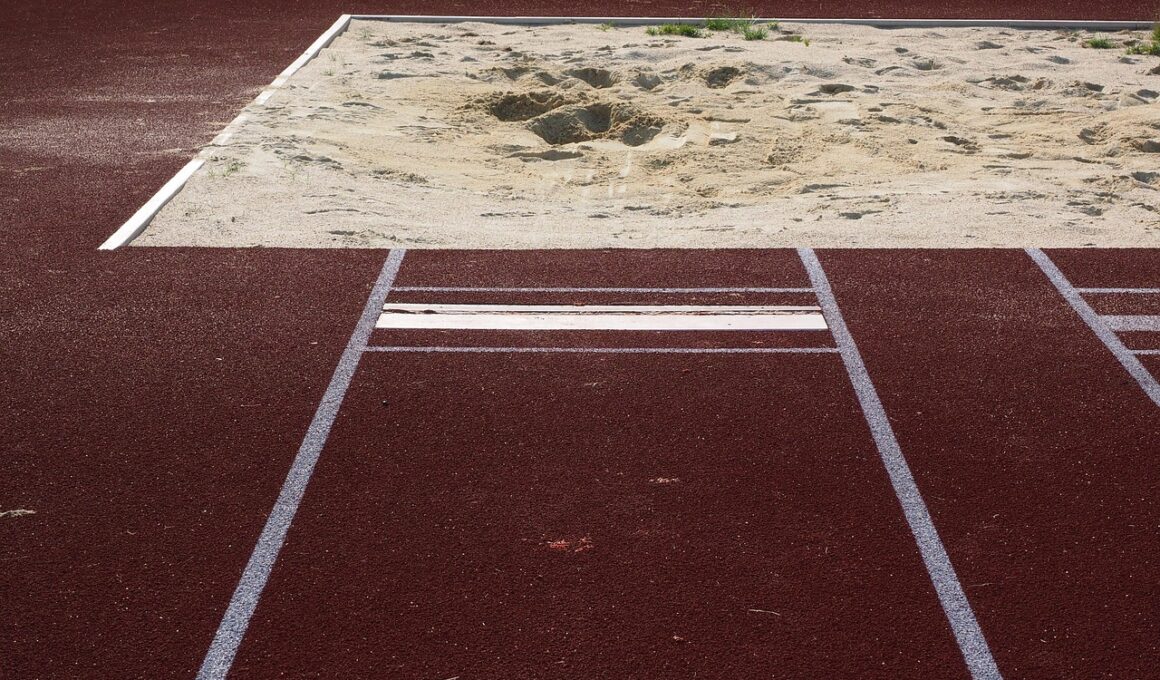Combining Speed and Agility Training for Youth Triple Jump
The youth triple jump is a dynamic and complex athletic event requiring a blend of speed, agility, and technique. To excel in this discipline, young athletes must develop strength and coordination, enabling them to perform take-offs effectively. One of the key aspects in training for the triple jump involves enhancing speed and agility, which are crucial during the approach and jump phases. Athletes should engage in a variety of drills designed specifically to improve these components. A good way to start is by incorporating acceleration sprints, which focus on explosive speed over short distances. Additionally, plyometric exercises like box jumps and hurdle hops can increase their power and reaction. Such methods not only enhance jumping ability but also improve overall athletic performance. Athletes should also include agility ladders or cones in their training regimen to develop foot speed and quickness. Through these exercises, young athletes can learn to maintain balance and control while performing complex movements. Therefore, a tailored training program strengthens not only physical capabilities but also instills confidence, contributing to their success in youth athletics.
The importance of injury prevention cannot be overstated, especially when considering the rigorous nature of youth athletics. Young athletes can be particularly susceptible to injuries related to improper technique or overtraining. Thus, integrating injury prevention strategies in regular training sessions for the triple jump becomes essential. Coaches and trainers should educate their athletes on proper warm-up routines, emphasizing dynamic stretching that prepares muscles for explosive action. Furthermore, athletes must be trained in correct landing mechanics to minimize impact on their joints during the jump. This includes practicing soft landing techniques that distribute force evenly upon landing. Another key component is emphasizing the use of appropriate footwear designed specifically for jumping activities. Wearing shoes that offer adequate support and cushioning will help mitigate injury risks associated with shock and impact. Athletes should also be encouraged to listen to their bodies, taking necessary rest days when feeling fatigued. By incorporating these injury prevention methods into routine training, young athletes can continue to develop their skills in a safe environment. This holistic approach ultimately fosters a longer, more fulfilling athletic career.
Incorporating Speed Training Techniques
Integrating speed training techniques is vital for enhancing young athletes’ performance in the triple jump. Various forms of speed drills significantly improve speed and explosiveness, leading to better jump outcomes. Sprint drills such as hill sprints are particularly effective; they require athletes to exert greater effort while running uphill, thus building strength in the legs. Coaches can also enhance speed using resistance training methods like parachutes or sled pulls, which further develop the power behind each stride. Regularly incorporating timed sprints into workouts helps athletes track their progress. But speed training shouldn’t focus solely on distance; short bursts of acceleration over 20-30 meters are ideal for mimicking the intense but brief effort needed during the jump. Another useful method is the use of flying sprints, where athletes gradually build speed before sprinting at maximum capacity for distance. Complementary to these drills, technique refinement is equally essential to eliminate inefficiencies in the athlete’s running style. Combined with strength training, these speed drills provide a comprehensive approach to preparing youth for the demands of competitive triple jumping.
Agility training forms another essential component of athletic preparation for young triple jumpers. It allows athletes to develop the quickness and coordination needed to execute the complex series of movements involved in the event. Incorporating agility drills can significantly enhance performance in the approach phase of the jump. One highly effective exercise involves ladder drills, which promote overall foot speed and enhance body control. Various patterns can be incorporated into the routine, such as in-and-out or lateral shuffles, challenging the athlete’s coordination and mental focus. Cone drills also offer an opportunity to sharpen agility; these Challenge young athletes to accelerate and decelerate with precision and speed while changing direction. Additionally, agility hops, where athletes jump from one foot to another over obstacles, improve balance and explosiveness. It’s also crucial for athletes to practice their approach run, mimicking real jump conditions while incorporating agility-focused strategies. This targeted practice hones the skills required to confidently transition from speed to the jump phase. Overall, a strong emphasis on agility in training builds a solid foundation for success in youth athletics, particularly in the triple jump.
Building Strength for Optimal Performance
Strength training plays a crucial role in maximizing the performance of youth athletes participating in the triple jump. To achieve optimal results, young athletes should focus on exercises that target the core, legs, and overall body strength. Compound movements such as squats, lunges, and deadlifts build the necessary leg muscles for take-off and landing, which are pivotal in the triple jump. Implementing weight training should be done with care to avoid injuries, emphasizing correct technique and gradual load increase. Additionally, bodyweight exercises like push-ups and pull-ups help improve upper body strength, promoting overall power during jumps. Athletes can also use plyometric workouts to enhance fast-twitch muscle fibers, directly contributing to explosiveness. Exercises like squat jumps or bounding will develop power and further increase vertical jump ability. Stretching routines focused on flexibility must accompany strength training; this combination maintains the athlete’s range of motion, preventing tightness and injuries. By incorporating a balanced strength program, young athletes will see improvements in their performance and can enjoy a gratifying journey in youth athletics.
Nutrition is an often-overlooked aspect of training, yet it plays a significant role in an athlete’s success in the triple jump. Proper nutrition fuels young athletes’ bodies and supports recovery, ensuring they have the energy to train effectively. A well-rounded diet rich in whole foods, including lean proteins, fruits, vegetables, and whole grains, is essential. Protein is crucial for muscle repair and growth, while carbohydrates provide the necessary energy for intense training sessions. Hydration is also a vital factor; athletes should prioritize drinking sufficient water throughout the day and during workouts. Implementing a post-workout recovery plan that includes a balanced meal can further enhance performance. Healthy snacks with a combination of protein and carbohydrates can promote muscle recovery and replenish energy stores. Young athletes should be educated about making healthy food choices and the importance of avoiding processed foods high in sugar. Coaches can introduce snack ideas and meal preps that fit their training sessions. By taking nutrition seriously, young athletes will undoubtedly experience improved performance in their events, stamina during training, and enhanced overall health.
Creating a Supportive Training Environment
A supportive training environment is pivotal for fostering the development and success of youth athletes. A positive atmosphere encourages young jumpers to push their limits, enhancing their skills in a safe and nurturing space. Coaches play an instrumental role in maintaining this environment, focusing on encouragement and constructive feedback rather than excessive criticism. Additionally, fostering camaraderie among teammates can create a motivating setting where athletes lift each other and share their experiences. Team-based exercises and relays can help build these bonds while reinforcing a sense of responsibility and teamwork. It’s also essential for parents or guardians to remain actively supportive, attending practices and competitions to provide encouragement. Open communication between coaches, parents, and athletes promotes an understanding of each individual’s goals and aspirations. Establishing realistic expectations is key; athletes should celebrate small victories and improvements rather than solely focusing on competition outcomes. By cultivating this supportive community, athletes can thrive, steadily building their passion for triple jumping in youth athletics, ultimately leading to contributions on and off the track.
In conclusion, training for youth triple jump athletes requires a well-rounded approach focusing on speed, agility, strength, and injury prevention. Integrating various training techniques is crucial for developing young jumpers into proficient athletes. Engaging in speed drills and agility exercises enhances performance, fostering the necessary quickness and coordination needed during practice and competitions. Additionally, prioritizing strength training and proper nutrition helps build a strong foundation crucial for achieving optimal performance. Coaches and trainers should focus on creating a supportive environment where young athletes feel encouraged and valued. By continually emphasizing injury prevention and holistic training methods, coaches can help protect athletes’ well-being and longevity in the sport. Ultimately, fostering a love for athletics and providing youth with the tools they need to excel will contribute to their successes as triple jumpers and overall athletes. As they progress through their training journey, athletes will appreciate the connections forged and the lessons learned in teamwork, discipline, and resilience. Embracing a comprehensive training program, they can enjoy a fulfilling and enriching experience in youth athletics.


